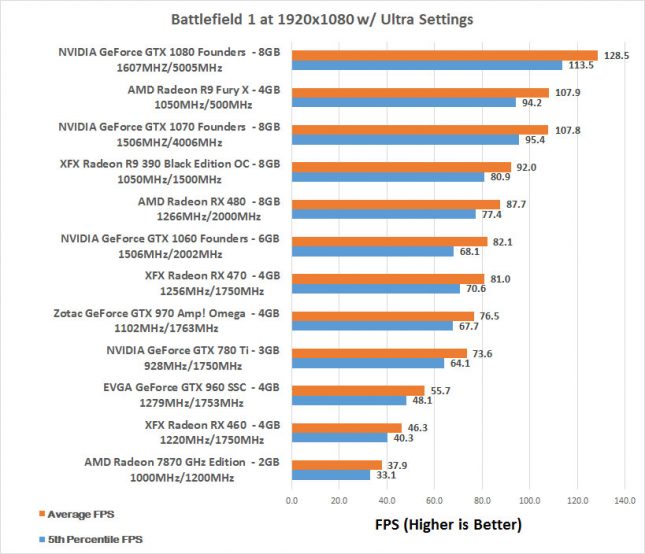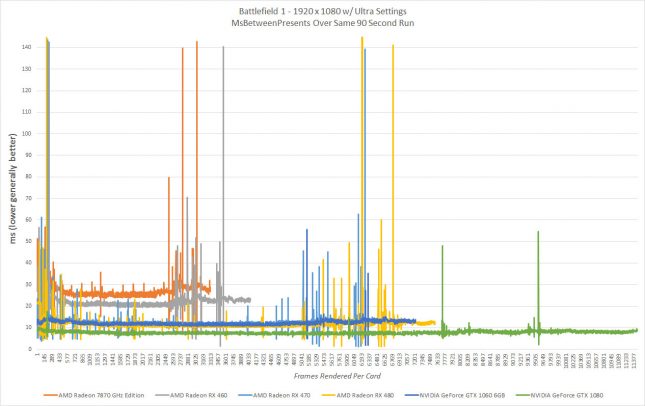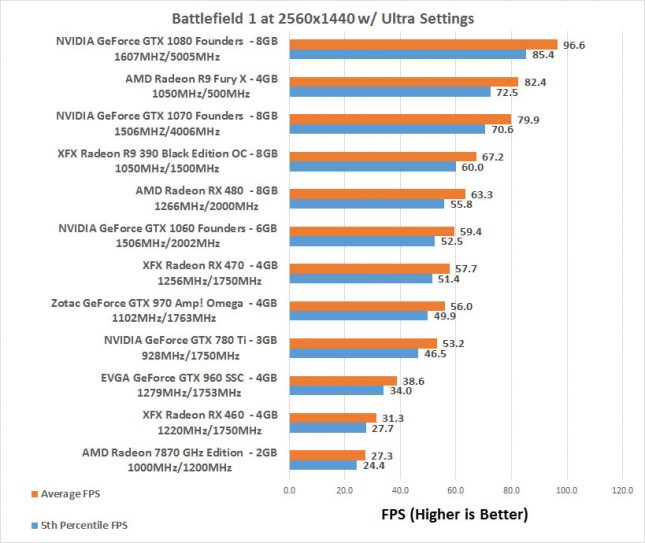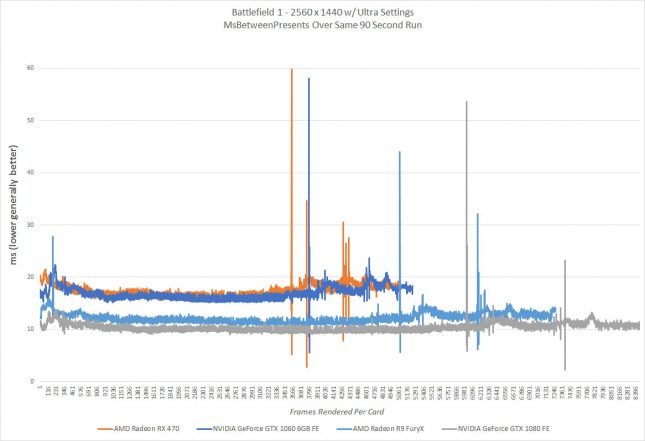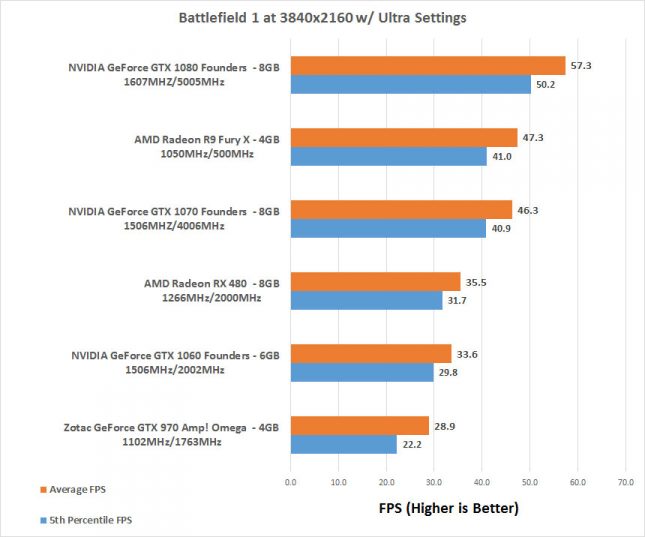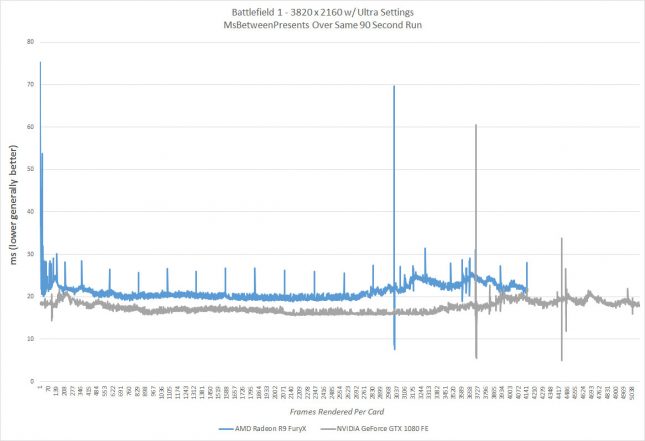Battlefield 1 DX12 Benchmarks – Three Resolutions Tested on Dozen Video Cards
Battlefield 1 Benchmarks – 1080p, 1440p & 4K
Battlefield 1 Benchmarked – 1080P
1080p, also known as Full HD, is still by far the most popular desktop resolution and the one that most gamers are interested in due to this fact. The September 2016 Steam Hardware Survey results showed that 1920 x 1080 is the primary display resolution by 37.27 percent of gamers!
1080P Benchmark Results: We manually benchmarked 12 video cards in Battlefield 1 using Presentmon and are showing you the average framerate and then used an equation to come up with the 5th percentile framerate to show you what the bottom 5% of each card is. Here you can see if you want to play Battlefield 1 at 1920 x 1080 you better be using something like an AMD Radeon RX 470 4GB or an NVIDIA GeForce GTX 970 Ti 3GB graphics card. We were a bit shocked to see the older NVIDIA GeForce GTX 780 Ti able to stay above 60 FPS, but that was always a solid performing card. The NVIDIA GeForce GTX 1080 8GB Founders Edition takes the top spot over the AMD Radeon Fury X 4GB. AMD cards in general did pretty well on this benchmark as the AMD Radeon RX 470 was performing basically the same as the GeForce GTX 1060 6GB Founders Edition.
Presentmon gave us all sorts of interesting data and one thing that doesn’t show up in our charts is some hesitation or stutters that we feel when playing on AMD Radeon graphics cards. We looked and on the AMD Radeon RX 460 4GB, Radeon RX 470 4GB and Radeon RX 480 8GB we had 1-2 frames that were over 140ms, which is 7.1 FPS. When you are cruising along and a fairly steady frame rate you’ll tend to notice these areas as a stutter. Even the older AMD Radeon 7870 GHz Edition 2GB video card from 2012 had this trait, so this impacts more than just the latest AMD series cards. NVIDIA on the other hand doesn’t spike nearly as bad as the GeForce GTX 1060 6GB and GeForce GTX 1080 8GB only went over 50ms once or twice each. 50ms is only 20 FPS, so even the fastest card in our charts that averaged 128 FPS had a few slow downs that some people might notice. After talking to multiple people and sharing our performance results with them we learned that this is similar to the results that AMD got on this particular section of the game. AMD did internal testing on 4 parts of Battlefield 1 and we just happened to benchmark the one spot that exhibited this issue. AMD is going to put in a request for the driver team to look at this further on 10/24/2016 and hopes that a driver update will help smooth this out. It could be something as simple as how EA/DICE is handling the memory management as this is only seen on DX12 as this issue is not present in DX11. AMD sent the press a Battlefield 1 reviewers guide that only showed how to find the average FPS, so maybe this is why they didn’t want people to look at the lows and highs? Usually right after the low point there is an extreme high, so something is going on over our pay grade and hopefully some driver updates along with a soon to be released game patch will right all this.
This is likely why there are dozens of people complaining about Battlefield 1 FPS Drops over on the Battlefield 1 PC community and we hope this article and getting AMD to open a ticked on it today will get it resolved for everyone.
Battlefield 1 Benchmarked – 1440p
Moving up to 2560 x 1440 or Quad HD resolution is gaining in popularity thanks to lowering prices on displays and the fact that you can get a 144Hz panel at this resolution. This display resolution isn’t as demanding as 4K, so for gamers it really is the sweet spot when it comes to gaming resolutions.
1440P Benchmark Results: If you want to average above 60 FPS you better be running something like an AMD Radeon R9 390 or an NVIDIA GeForce GTX 1070 as things start to get tougher on the cards when you increase the resolution. The NVIDIA GeForce GTX 1070/1080 cards could handle this no problem, but the AMD Radeon RX 480 was dipping below 60 FPS on the lows. In general AMD cards do very well and the difference between the Radeon RX 470 4GB and GeForce GTX 1060 6GB wasn’t really that great.
When looking at the frametime data we were shocked to find that the high ‘spikes’ seen at 1920 x 1080 were no where to be found, but both AMD and NVIDIA cards were found to slow down to 45-60 ms on 1-2 frames per card.
Battlefield 1 Benchmarked – 4K
4K or Ultra HD has four times the pixels of the ‘standard’ 1080p display and is considered one of the most demanding widely used gaming resolution.
4K Benchmark Results: We dropped off some of the slower cards that weren’t designed for 4K gaming off this chart, but as you can see none of the cards did really well at 4K resolutions with the default Ultra image quality settings. If you drop the image quality down to medium you’ll get average over 60 FPS on the NVIDIA GeForce GTX 1080 8GB FE, so 4K gamers will need to reduce the image quality to get the frame rate up for a good gaming experience.
When we look at frametime performance we see a couple spikes on both cards, but we noticed almost a pattern to over 25 little spikes on the AMD Radeon R9 Fury X when playing BF1 on an Ultra HD display. The spikes were generally ever 250 frames and we about 6-7ms higher than the ones before and after it. Pretty strange behavior, but likely has something to do with the memory usage once again.
Battlefield 1 Performance Final Thoughts
Battlefield 1 was tough to benchmark due to using Presentmon to get the job done, but our test results were interesting to say the least. AMD Radeon graphics cards do very well on this DirectX 12 game title when you look at the average FPS, but they appear to be suffering from some massive FPS drops when playing at 1920 x 1080. You can be playing with respectable frame rates and then all of a sudden the performance plummets down to the single digits. NVIDIA graphics cards also experience some FPS drops, but to a lesser degree.
We’ve seen a few people online that said the new GeForce GTX 375.63 drivers that came out yesterday fixed the issue, but that isn’t true as there were no BF1 tweaks to be had in that driver. The only change in GeForce 375.57 drivers was a fix for some Windows 10 UI issues that were impacting the start menu and titles. When Battlefield 1 is run in DX12 mode the game developers control how the video cards memory is handled due to the access to the low level programming that they have. We have a feeling that this will need to be addressed in a future game patch unless AMD and NVIDIA can force something in a driver release. Much of that is over our head though as we have no experience programming APIs.

